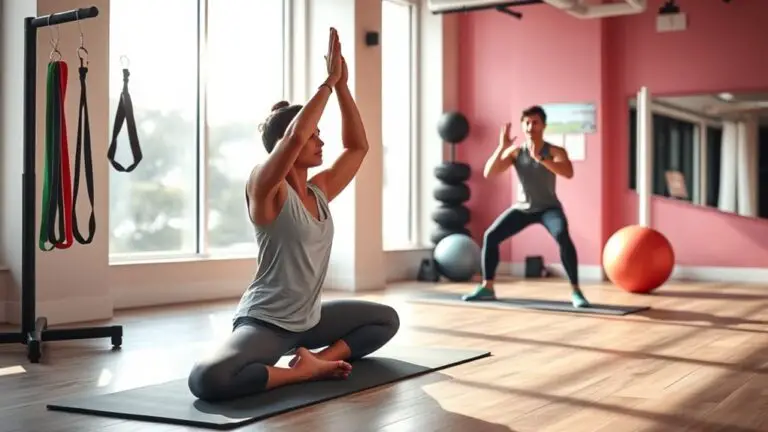The Best Chest Workouts for Mass and Strength

To build mass and strength in your chest, focus on classic exercises like the barbell and dumbbell bench press, and incorporate incline presses to target the upper chest. Don’t forget isolation movements such as dumbbell flyes and cable crossovers to refine muscle definition. Including bodyweight exercises can enhance your gains too. Prioritize safety and progressive overload for the best results. Stick around to discover more tips to elevate your chest workouts even further.
The Importance of Chest Training for Overall Fitness

When you think about building a balanced physique, chest training often gets overlooked, yet it plays a crucial role in overall fitness. A strong chest not only enhances muscle symmetry but also contributes to functional strength, which is necessary for daily activities and overall health. Neglecting your chest can lead to imbalances, affecting your posture and performance in other exercises.
Incorporating chest workouts into your routine helps develop the pectoral muscles, promoting stability and strength in upper body movements. This can improve your ability to perform tasks like lifting and pushing safely. It’s important to approach chest training with proper form and controlled movements to minimize the risk of injury. By prioritizing chest exercises, you’re investing in a well-rounded fitness regimen that supports your goals and promotes longevity in your training journey. So, don’t skip out on those chest workouts; they’re key for both aesthetics and functionality.
Classic Chest Exercises: Bench Press Variations
While there are many chest exercises out there, bench press variations remain some of the most effective for building mass and strength. When performed correctly, both the barbell bench and dumbbell bench can enhance your chest development while minimizing injury risks. Here’s a quick comparison of these variations:
| Exercise Type | Benefits | Safety Tips |
|---|---|---|
| Barbell Bench | Greater weight capacity | Use a spotter for heavy lifts |
| Dumbbell Bench | Improved range of motion | Maintain a neutral wrist position |
| Incline Barbell | Targets upper chest | Adjust bench for comfort |
| Decline Dumbbell | Focuses on lower chest | guarantee proper form at all times |
Incorporating these variations into your routine can lead to substantial gains. Always prioritize safety by using proper form, and consider starting with lighter weights to master your technique.
Targeting the Upper Chest: Incline Press Techniques

To effectively target the upper chest, mastering incline press techniques is essential for balanced development. Incorporating these exercises into your routine can help enhance your upper chest strength and aesthetics while ensuring safety.
Here are four key techniques to evaluate when performing the incline press:
- Adjust the Bench: Set your bench at a 30-45 degree angle to focus on the upper chest without overstraining your shoulders.
- Grip Width: Use a grip slightly wider than shoulder-width to engage the upper chest more effectively.
- Controlled Movement: Lower the weights slowly and maintain control throughout the lift, preventing injury and maximizing muscle engagement.
- Breathing Technique: Inhale as you lower the weight and exhale during the press to maintain core stability and support your back.
Isolation Movements: Flyes and Cable Exercises
Isolation movements, like flyes and cable exercises, are essential for sculpting and defining the chest muscles. Incorporating dumbbell flyes into your routine allows you to target the pectoral muscles more precisely. When performing these, maintain a slight bend in your elbows and focus on a controlled motion to avoid strain.
Cable crossovers are another fantastic option, providing constant tension throughout the movement. Make sure you adjust the cables to shoulder height and keep your movements smooth and steady. As you bring your hands together, squeeze your chest muscles for maximum contraction.
Always prioritize proper form over heavier weights to prevent injuries. Using lighter weights with controlled movements will help you achieve better results while keeping your joints safe. Include these isolation exercises in your chest workouts to enhance muscle definition and strength effectively.
Incorporating Bodyweight Exercises for Chest Development

Building on the foundation of isolation movements, incorporating bodyweight exercises can greatly enhance your chest development. These exercises not only build strength but also improve stability and control, making them perfect for all fitness levels. Here are four key bodyweight exercises you should consider:
- Bodyweight Push Ups: A classic move that targets your chest, shoulders, and triceps. Modify your stance to adjust difficulty.
- Chest Dips: These focus on the lower chest and triceps. Make sure you keep your body upright to reduce shoulder strain.
- Incline Push Ups: Elevate your hands to shift emphasis to the upper chest, perfect for variety in your routine.
- Decline Push Ups: Place your feet on an elevated surface to target the lower chest more intensely.
Incorporating these exercises into your routine can create a balanced workout while promoting safety and effectiveness.
Tips for Maximizing Chest Workout Effectiveness
While many people focus on the exercises themselves, maximizing the effectiveness of your chest workouts also hinges on key strategies that enhance performance and results. First, prioritize progressive overload. Gradually increase weights or resistance to challenge your muscles, making certain they adapt and grow stronger over time. It’s essential to track your progress to avoid plateaus.
Next, pay attention to your workout recovery. Adequate rest between sessions allows your muscles to repair and grow, which is vital for building mass and strength. Aim for at least 48 hours of recovery before targeting the chest again.
Incorporate proper nutrition, focusing on protein intake to support muscle repair. Stay hydrated and consider warming up before workouts to prevent injuries. Finally, listen to your body—if something feels off, don’t push through pain. By following these tips, you’ll guarantee your chest workouts are both effective and safe.
Frequently Asked Questions
How Often Should I Train My Chest Each Week?
When it comes to chest training frequency, most experts recommend hitting your chest about twice a week. This allows for enough recovery time between sessions, which is vital for muscle growth and preventing injury. Listen to your body; if you feel overly sore or fatigued, consider adjusting your schedule. Prioritizing proper form and adequate rest will help you achieve your goals safely while minimizing the risk of overtraining.
What Should I Eat for Optimal Chest Muscle Growth?
To sculpt your chest like a masterful artist chiseling marble, you’ll need to nourish your muscles wisely. Focus on lean protein sources—think chicken, fish, beans, and Greek yogurt—that’ll fuel your growth. Meal timing is essential; aim to consume protein shortly after your workouts, allowing your body to recover and build. Remember, a balanced diet rich in healthy fats and carbohydrates will also support your overall strength and safety on this fitness journey.
Is It Necessary to Warm up Before Chest Workouts?
Yes, it’s definitely necessary to warm up before your chest workouts. A proper warm-up routine can help prevent injuries and improve your performance. Incorporating dynamic stretching into your warm-up prepares your muscles and joints for the workout ahead. It gets your blood flowing and enhances your range of motion, making your chest exercises more effective. So, don’t skip this vital step; your body will thank you for it!
Can I Train Chest and Triceps on the Same Day?
Absolutely, you can train chest and triceps on the same day! In fact, studies show that combining muscle groups can enhance overall strength. Training these two together takes advantage of their synergy, allowing you to maximize your workout efficiency. Just remember to warm up properly to prevent injuries. On chest day, focusing on compound movements like bench presses can really benefit your triceps, making for a productive session.
How Can I Prevent Injury During Chest Exercises?
To prevent injury during chest exercises, it’s vital to prioritize proper form. Always start with a lighter weight to guarantee you’re executing movements correctly. Focus on your posture, keeping your back straight and shoulders down. Warm up properly, and don’t skip stretching afterward. Listen to your body—if something feels off, stop. Incorporating rest days into your routine also aids in injury prevention, allowing your muscles time to recover and strengthen.





